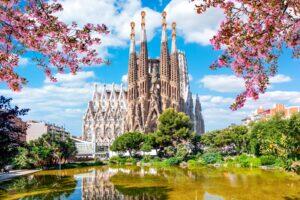Fodor's Expert Review Plaça del Rei
This little square is a compact nexus of history. Long held to be the scene of Columbus's triumphal return from his first voyage to the New World—the precise spot where Ferdinand and Isabella received him is purportedly on the stairs fanning out from the corner of the square (though evidence indicates that the Catholic Monarchs were at a summer residence in the Empordá)—the Palau Reial Major (admission included in the €7 entrance fee for the Museu d'Història de Barcelona; closed Monday) was the official royal residence in Barcelona. The main room is the Saló del Tinell, a magnificent banquet hall built in 1362. To the left is the Palau del Lloctinent (Lieutenant's Palace); towering overhead in the corner is the dark 15th-century Torre Mirador del Rei Martí (King Martin's Watchtower). The 14th-century Capella Real de Santa Àgueda (Royal Chapel of St. Agatha) is on the right side of the stairway, and behind and to the right as you face the stairs is the Palau Clariana-Padellàs,... READ MORE
This little square is a compact nexus of history. Long held to be the scene of Columbus's triumphal return from his first voyage to the New World—the precise spot where Ferdinand and Isabella received him is purportedly on the stairs fanning out from the corner of the square (though evidence indicates that the Catholic Monarchs were at a summer residence in the Empordá)—the Palau Reial Major (admission included in the €7 entrance fee for the Museu d'Història de Barcelona; closed Monday) was the official royal residence in Barcelona. The main room is the Saló del Tinell, a magnificent banquet hall built in 1362. To the left is the Palau del Lloctinent (Lieutenant's Palace); towering overhead in the corner is the dark 15th-century Torre Mirador del Rei Martí (King Martin's Watchtower). The 14th-century Capella Real de Santa Àgueda (Royal Chapel of St. Agatha) is on the right side of the stairway, and behind and to the right as you face the stairs is the Palau Clariana-Padellàs, moved to this spot stone by stone from Carrer Mercaders in the early 20th century and now the entrance to the Museu d'Història de Barcelona.
READ LESS









